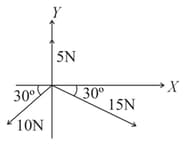Resultant and Component
Resultant and Component: Overview
This topic covers concepts, such as, Resultant Force, Parallelogram of Forces & Resolution of a Force into two Perpendicular Components etc.
Important Questions on Resultant and Component
Find the resolved parts of the force whose inclination to one of the resolved parts is given alongside as .
Find the resolved parts of the force whose inclination to one of the resolved parts is given alongside as .
The law of parallelogram of forces gives the resultant of
Derive the expression for resultant magnitude and direction of two force acting at a point.
State the law of parallelogram of two forces.
A force of is making an angle of with x-axis, Find the magnitude of the vertical component.
A force is inclined at to the horizontal. If the rectangular component in horizontal direction is Find the magnitude of the force and its vertical components respectively.
A child pulls a rope attached to a stone with a force of The rope makes an angle of degrees to the ground. What is the effective force along the horizontal direction?
The X- component of a force of is , then what will be the Y-component of the same applied force?
A force of is resolved into the perpendicular components. If the first component makes with the force the magnitudes of the components are:
If the forces are unbalanced, the resultant force is zero.
Let us have three forces as , , and . These are acting on a body simultaneously. The direction of is opposite to the direction of the other two. Determine the resultant force.
A body of mass is kept on a rough horizontal surface (friction coefficient ). A person is trying to pull the body by applying a horizontal force but the body is not moving. The force by the surface on the body is where
A object is subjected to two forces and . The magnitude of resulting acceleration in will be
Two vectors and have equal magnitudes. The magnitude of is times the magnitude of . The angle between and is
Two forces and of magnitude and , respectively, are at an angle with each other. If the force is doubled, then their resultant also gets doubled. Then, the angle is
Find the magnitude of the resultant of shown forces in plane.

A ball of mass is thrown vertically upwards by applying a constant force by hand. If the hand moves while applying the force and the ball goes upto height further, find the magnitude of the force. Consider .
